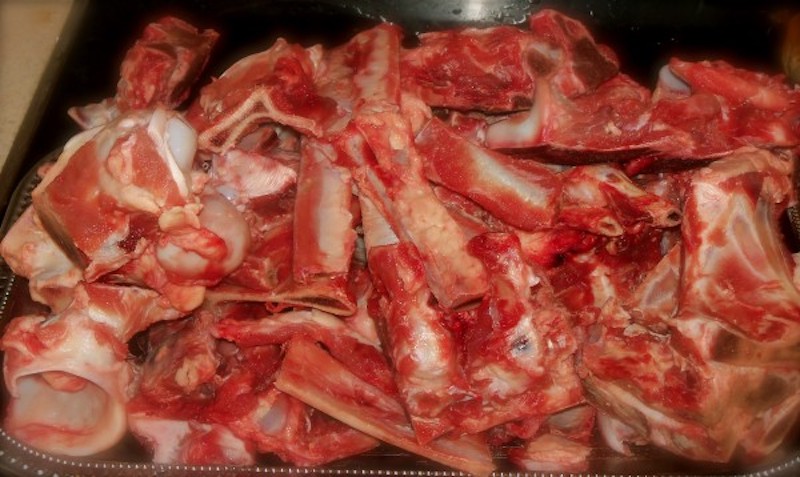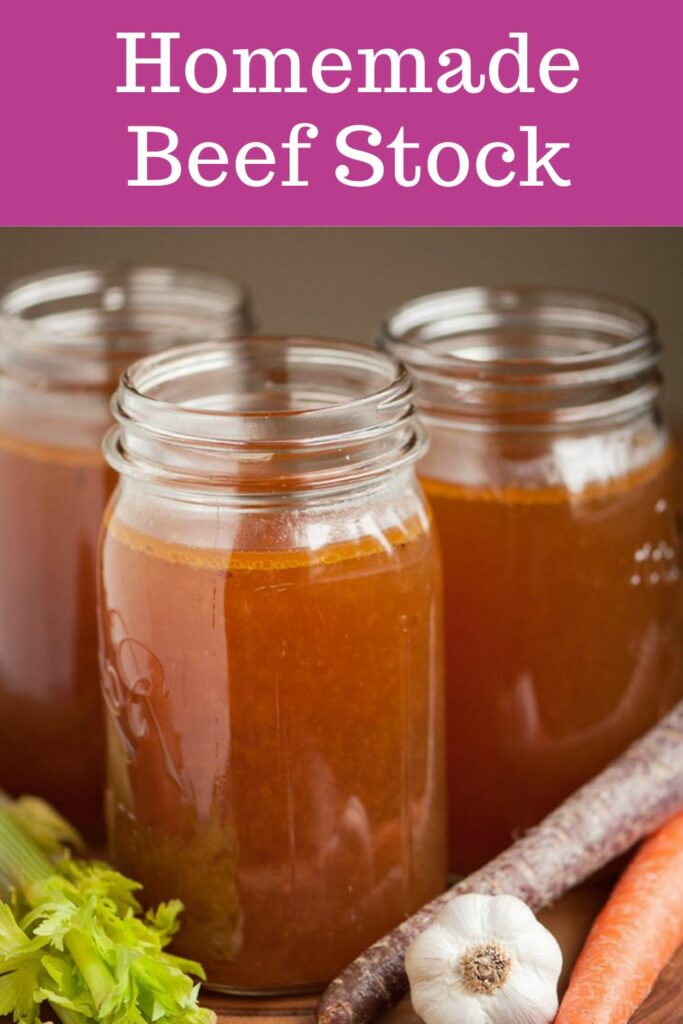Store-bought beef broth does not even hold a candle compared to beef stock made from scratch at home. Making your own beef stock at home is highly nutritious in more ways than one, and makes a great use of the whole animal. Thanks to modern day processing people have forgone this age-old traditional practice. Homemade Beef Stock from healthy animals contains minerals that are highly assimilable. Not to mention, beef stock contains gelatin which acts first and foremost as an aid to digestion and has been used successfully in the treatment of many intestinal disorders, including hyperacidity, colitis, and Crohn’s disease. Gelatin is by no means a complete protein, it acts as a protein sparer, allowing the body to more fully utilize the complete proteins that are taken in. Gelatin-rich broths are very important for those who cannot afford large amounts of meats in their diet. Which is where my family is at, low budget, so I make stock to have soups every day, this is a great budget stretcher. You will not find the same health benefits in a carton of store bought stock I guarantee you!
The other beautiful thing about making your own beef stock is the amount of fat that it contains. As a strong supporter of saturated animal fats in the diet, this is a fabulous bonus to the already great nutrition that comes from homemade beef stock. After having listened to Dr. Natasha Campbell McBride last weekend at the WAPF conference, she stated that we need to get about 40% of our daily diet as animal fat. She also noted that if you are constipated, then you need to eat more animal fat. Well, this past week I followed her advice and focused on getting more fat into my diet, and I have already experienced good results. Now I must make a quick disclaimer, if you are not already consuming more generous amounts of fats, it’s not wise to dive into the deep end of the pool. Transitioning into consuming fats from a lower fat lifestyle should be slow and perhaps started with coconut oil, butter and maybe chicken fat. This will help your gallbladder get back into commission again in a gentle way and will be easier on your tummy.
To find good quality bones for stock, purchase grass fed bones from your Farmer’s Market or ask for all the bones when purchasing a side or portion of beef from a farmer. Whole Foods also carries marrow bones and other cuts of grass fed beef that would work for stock, like meaty rib bones or even oxtail. Using a calves foot will help give your stock a better gel, but is not necessary. It’s also a very good idea to go ahead and make as much stock as you can, double or even triple this recipe to make as many as 15 or so quarts of stock.

Homemade Beef Stock
Ingredients
- About 4 pounds beef marrow and knuckle bones
- 1 calves foot cut into pieces (optional)
- 3 pounds meaty rib or neck bones you can also use assorted bones saved from roasts, scraps and trimmings, cartilage and sinew saved from other cuts of beef
- 4 or more quarts cold filtered water enough to cover the bones by 2 to 3 inches
- ½ cup raw apple cider vinegar
- 3 large onions coarsely chopped (or, several leeks)
- 3 carrots coarsely chopped
- 3 celery sticks coarsely chopped
- 1 whole head of garlic cloves peeled and coarsely chopped
- A palm full of crushed peppercorns
- Several bay leaves
- 1 bunch of parsley optional
- Several sprigs of fresh thyme
Instructions
- It is important to use several sorts of bones: knuckle bones and feet impart large quantities of gelatin to the broth; marrow bones impart flavor and the particular nutrients of bone marrow, and meaty rib or neck bones add color and flavor.
- Place the knuckle and marrow bones and optional calves foot in a very large pot with vinegar and cover with water. Let stand for one hour.
- Meanwhile, place the meaty bones in a roasting pan and brown at 350 degrees in the oven.
- When well browned (this can take as little as 20 minutes), add them to the pot along with the vegetables.
- Pour the fat out of the roasting pan, and add to the stock pot.
- Add enough cold filtered water to the pot to cover the bones by 2-3 inches, leaving at least one inch of room from the top of the pot, as the volume expands a bit during cooking.
- Bring to a boil.
- A large amount of scum will come to the top, and it is important to remove this with a spoon. After you have skimmed, reduce heat and add the thyme, bay leaves and crushed peppercorns.
- Simmer stock for at least 12 and as long as 72 hours. (I prefer to let mine go for the full 72 hours.)
- Just before finishing, add the parsley and simmer another 10 minutes.
- Remove the bones and save them for another batch of stock. I usually reuse my bones at least once for smaller bones and up to 3 times for much larger bones in another batch. I will get some fresh meaty bones to mix up with the already used bones to ensure I get some more flavor and nutrients.
- Strain the stock and cool in the fridge.
- Your jars of stock will have a layer of congealed fat on top and you can leave that in or remove it and save it for cooking with.
- Your stock should also be very thick and gelatinous when cooled.
The marrow can be removed from bones and eaten or even given to a pet. You can also use the congealed fat to make pemmican or if you so desire feed the birds or a pet with. (not me, I’ll be consuming all that good fat!)

Also, you do not have to waste the bones after just one batch of stock, you can use them again to make more stock. After each batch of stock, I save the bones in a large bag in the freezer. When I am ready to make another batch of stock, all I need is some meaty bones or oxtails to add to the used bones. This helps to add flavor, fat and more gelatin to the next batch of bone broth. I have used beef bones many many times before throwing them away. When they start to crumble you may want to discard them. The larger marrow bones last the longest.






